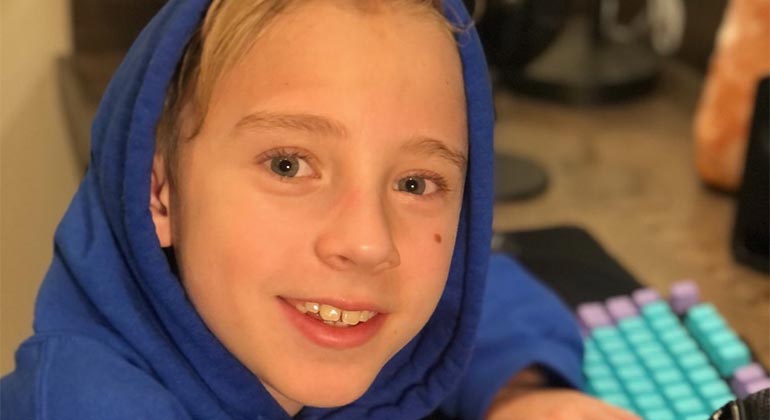
10-Year-Old Thriving After “Ross Procedure” Repairs Congenital Aortic Valve Condition
Barrett Williams was born in Santa Barbara, California with a malformed heart valve. He was diagnosed with aortic stenosis and a unicuspid valve. It isn’t unusual for children to be born with congenital heart conditions. Almost one out of every 100 children has some heart issue at birth, according to the Centers for Disease Control and Prevention.
When Barrett was 2 months old, surgeons performed a procedure to open up the valve, but his parents knew that wouldn’t be a long-lasting fix. At some point, Barrett would need a permanent solution. His parents hoped to hold off until he was bigger and more developed, so it would be easier for his body to handle the surgery.
Barrett was lucky. His heart defect didn’t hold him back. He went to school, played with his friends, kept up with his peers in every way. When he was ten years old, a routine magnetic resonance imaging scan showed that he had developed a significant increase in his aortic valve regurgitation, a condition in which blood pumped out of the heart leaks back into it. He didn’t have many symptoms—just a little breathlessness. But his parents wanted to get Barrett treated before his condition got worse.
Cooper and Joanna, Barrett’s parents, researched and discovered that the best solution was probably a Ross procedure. In this open-heart approach, the surgeon removes the leaky aortic valve and replaces it with the patient’s own pulmonary valve, a mirror image of a normal aortic valve. Then the surgeon uses a pulmonary valve from a cadaver to replace the patient’s now-missing pulmonary valve. It is the only surgery that maintains a living autologous valve in the aortic position, a critical factor for successful long-term patient outcomes. The other options are either a mechanical valve, which forces patients to take blood thinners for life and to modify their lifestyle accordingly, or a tissue valve, which this means multiple future operations because these valves wear out very quickly in young patients (5-10 years).
The catch was that very few surgeons perform the Ross procedure in the state of Utah, where they have lived since 2015. Those vascular surgeons that do perform it have minimal experience in this highly technical and complex procedure. Barrett’s parents realized they would have to get him on a plane to a specialist, so they went back into research mode and contacted Ismail El-Hamamsy, MD, PhD, Director of Aortic Surgery for the Mount Sinai Health System, and a world leader in aortic reconstructive surgery. Dr. El-Hamamsy has performed more than 500 Ross procedures and has proctored numerous surgeons around the world to learn this operation. “We researched other surgeons but we always kept coming back to Dr. El-Hamamsy. We had a gut feeling he was the one. When we first called his office, we received a call back from him within the hour. He was professional, empathetic and we felt very comfortable with him. His experience with the Ross procedure was superior,” Joanna says.
“For someone who is young and active and wants to play sports—whether it's contact sports or things like skiing where you're at risk of falling and knocking your head—you have a much higher risk of major bleeding from taking blood thinners,” Dr. El-Hamamsy says in a Today.com article about Barrett’s journey. “We want to balance doing the surgery that will allow him to have a good quality of life.”
As if this weren’t enough of a challenge, Barrett would need this procedure during the COVID-19 pandemic. That made travel more challenging and meant only one parent could be with him in the hospital. Joanna and Barrett flew to New York and went to The Mount Sinai Hospital for the procedure. The surgery was successful, and four days after the operation, Barrett felt much better. Two weeks after the procedure, he and his mom flew back to Utah so Barrett could finish recuperating at home.
“The Ross procedure is the only replacement operation that allows us to restore life expectancy of these patients to that of the general population,” says Dr. El-Hamamsy. “There's no medication required. There are no limitations to what they can or cannot do or lifestyle modifications. It’s a perfectly normal quality of life.”
Barrett took it easy for the rest of the fall, and by Christmas, Dr. El-Hamamsy approved him to ski again. He’s looking forward to riding his mountain bike when the weather gets a little warmer.
Barrett’s parents are thrilled with the care Barrett received. “We really appreciate all the incredible work Dr. El-Hamamsy and Dr. Stelzer have done in this field, especially with the Ross Procedure. We could not have been more thankful to have two of the world’s best Ross surgeons with Barrett that day. Dr. El-Hamamsy’s team (including Dr. Paul Stelzer, Dr. Peter Pastuszko, Dr. Ingrid Hollinger, Roberto Galao Malo, NP, Leemor Selitto, and more) were incredible. They were there for us every step of the way and made it all possible. We are so grateful for their talents, exceptional care and for the gift they have given Barrett and our family. We hope that by sharing Barrett’s story we can help bring awareness to the Ross procedure for children needing valve replacement surgery.”